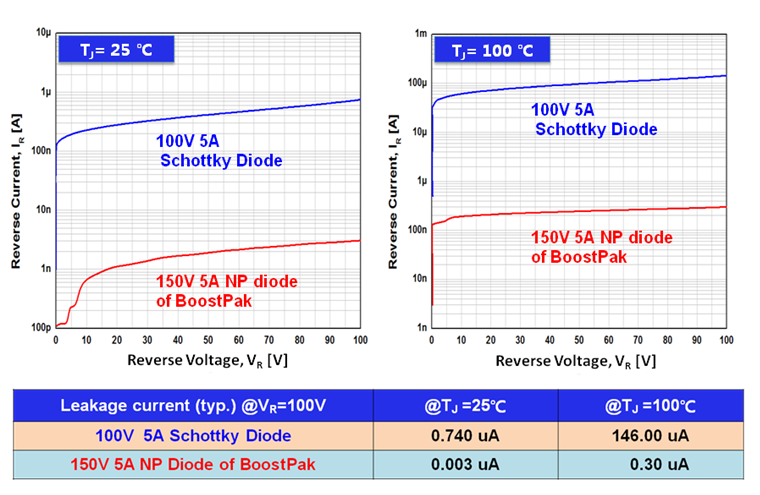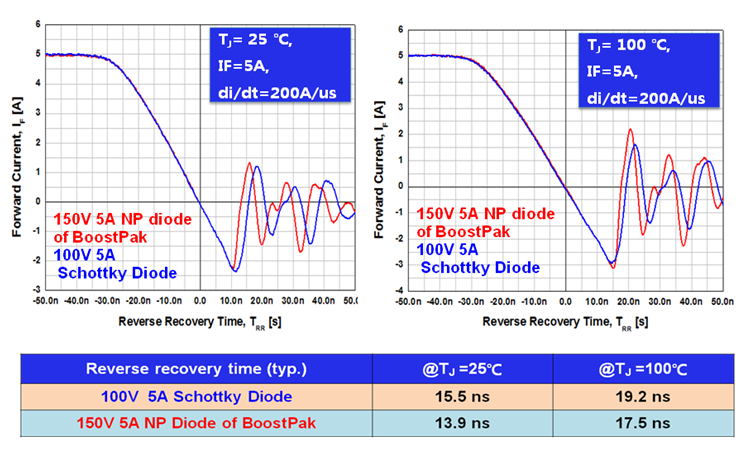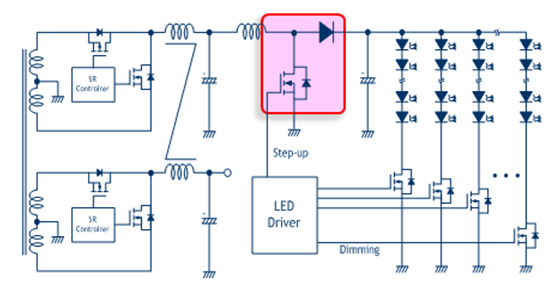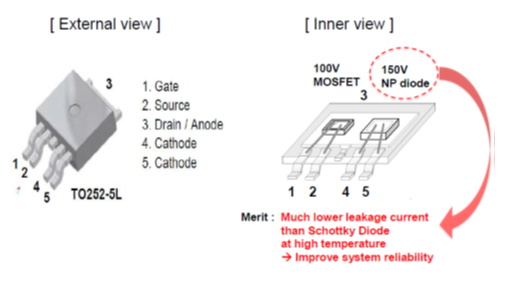Wonhwa Lee, Senior Marketing Manager at Fairchild Semiconductor talks in depth about the company's100 V BoostPak solution for LED backlight applications. Below is the full entry:
A standard way to configure the backlight is to use two discrete devices: a 100 V MOSFET in a DPAK package and a 100 V Schottky diode, also in a DPAK package. High leakage current of Schottky diode can be a problem in LED backlight units, especially at higher temperatures. Some customers have experienced leakage failure issue of Schottky diode during mass production. One way to improve the leakage failure is to increase the Schottky diode’s voltage rating from 100 V to 120 V, but leakage current can still be an issue when the system temperature is high. (All photos and graph copyrights belong to Fairchild Semiconductor.)
Our design team developed an alternative approach, using Fairchild’s new 100 V BoostPak solution. The BoostPak family (Figure 1) uses a single package to house two devices: a 100 V MOSFET and a 150 V NP diode.
The BoostPak family is housed in a single 5-lead DPAK package. The N-channel MOSFET has been tailored to minimize the on-state resistance while maintaining superior switching performance. The NP diode is a hyperfast rectifier with low forward voltage drop and excellent switching performance. It has a much lower leakage current than a Schottky diode, so it delivers better system reliability in high-temperature applications.
Compared to the two-discrete solution, the BoostPak approach uses a smaller footprint and can save as much as 20mm2 of PCB space. Using one package instead of two also means there’s less assembly work and lower system cost.
The BoostPak family is available in two versions, one with an output power rating of 25 W, the other with a rating of 40 W. Table 1 gives the details.
 |
|
Table 1. BoostPak Electrical Specs. |
Better Performance at Higher Temperatures
We wanted to see just how much lower the leakage current is for the NP diode, so we ran some tests. The results are shown in Figure 2.
 |
|
Figure 2. Comparison of Diode Leakage Current. |
Compared to a 100 V, 5A Schottky diode, the 150 V, 5 A NP diode in the BoostPak family has much lower ratings for leakage current under all conditions, but the differences at higher temperatures are particularly dramatic. As the temperature rises, the leakage current of the Schottky diode goes up rapidly, while the leakage current for the NP diode stays proportionally lower.
The NP diode of the BoostPak family is produced using an excellent lifetime control process to get very fast reverse recovery time and reasonable forward voltage drop (VF (typ.): 0.9V at IF=5A, TJ=100 degrees C)
The comparison of reverse recovery time is shown in Figure 3.
 |
|
Figure 3. Comparison of Diode Reverse Recovery Time. |
A Real-World Design
Our next step was to verify that the BoostPak family would limit leakage current in a real-world design, so we developed an evaluation board and tested it under various conditions. Figure 4 shows the basic design, with the BoostPak family highlighted.
 |
|
Figure 4. BoostPak in an LED Backlight. |
The design is for a 35 W boost topology that uses Continuous Current Mode (CCM) operation. The input voltage has a range of 20.4 V to 27.6 V and there is a single-channel DC output with a constant current of 640 mA at 55 V. We used the FDD8500N10LD version of the BoostPak family.
During CCM operation, the reverse recovery current of the diode increases the turn-on losses of the MOSFET. The NP diode offers a low reverse-recovery current, so there’s less impact on the MOSFET.
Testing for Temperature & EMI
In designing our BoostPak products, we had two particular goals in mind. First, we wanted to keep the device case temperature below 65 degrees C during operating. Second, we wanted to meet general guidelines for electromagnetic interference (EMI), with the aim of keeping EMI under the limits for CISPR22 Class B operation.
We measured the saturated temperature. As shown in Table 2, with an input voltage (VIN) of 24 V, the BoostPak family maintained a temperature of 61.5 degrees C, below our target of 65 degrees C.
 |
|
Table 2. Test Results of VOUT = 55 V (35 W) |
Next, we tested for EMI by examining radiated emissions for a load of five strings of LEDs. Figure 5 shows the results for a VIN of 24 V.
 |
|
Figure 5. Radiated Emissions: VIN = 24 V. |
In the frequency sub-range of 30 MHz to 1000 MHz, the radiated emissions are well below the specified limits for CISPR22 Class B operation.
Conclusions
The test results show that our BoostPak family, which replaces a 100 V MOSFET and 100 V Schottky with a single 100 V BoosPak family, meets the necessary performance requirements for operating temperature and EMI with low leakage current of diode. At the same time, using the BoostPak family serves to create a smaller, more compact design that is easier to assemble. In cost-competitive applications, such as LED TVs with a screen size less than 40 inches, those benefits can make a real difference. The BoostPak approach can also deliver savings in other applications, too, like LED lighting systems and DC/DC converters for step-up and step-down operations.
The BoostPak family discussed in this article is described in more detail in an User guide. The note provides a full schematic, a complete bill of materials, performance specs, and a summary of the test setup. To download the application note, visit the Fairchild website at: http://www.fairchildsemi.com/an/AN/AN-FEBD850N10LD.pdf


















